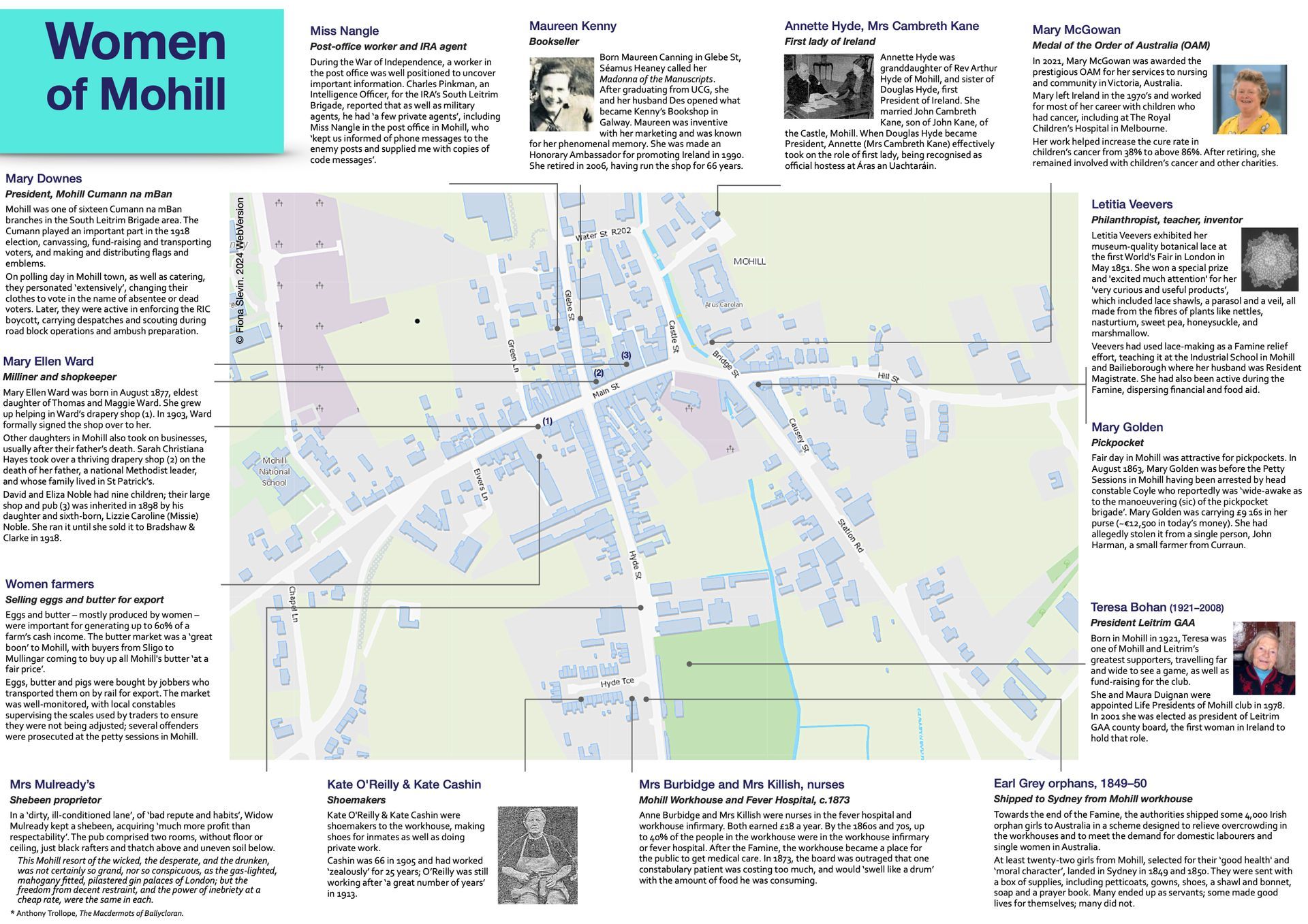Notable Mohill people
Read about people associated with the War of Independence and Civil War era here >>>
Lord Leitrim is covered in the History section, since most of this website deals with his era.
Some of the content here was researched and written by Michael Slevin, and the pieces posted on the original Mohill.com website back in the late 1990s.
_________________
In 2018, I asked OldMohill members on Facebook to suggest famous Mohill people: see their suggestions here >>>

Turlough O'Carolan (1670-1738)
Composer, harpist and last of the Irish bards
Turlough O Carolan (Toirdhealbhach Ó Cearbhalláin) was one of Ireland's best music composers and harpists, and is remembered as the 'last of the Irish bards'. He spent most of his life as a travelling composer, poet and harpist, but Mohill was his most permanent home.
O Carolan was born at Nobber, Co. Meath, in 1670 and moved with his father to near Carrick-on-Shannon in 1688, and then on to Ballyfarnon, co. Roscommon. His aptitude for music brought him to the attention and life-long patronage of Mrs McDermot Roe of Ballyfarnon. After losing his sight to smallpox, McDermot Roe sponsored his apprenticeship to a harper. Around 1691, she set him up with a guide, a horse, and money to make a living as an itinerant harper. He was also supported through his life by Charles O’Connor of Belanagare.
Early in his travels, O Carolan arrived at the house of George Nugent Reynolds in Keshcarrigan. It was Reynolds who suggested that O Carolan focus on composition (he was not deemed to be a brilliant player) and to add lyrics to his compositions. Reynolds’ told him of the fairy battles of Sheebeg and Sheemore, inspiring O Carolan to produce perhaps his most well-known, and possibly his first composition, ‘Sí Bheag Sí Mhór’, or Carolan's Concerto.
It is believed that O Carolan composed over 200 pieces, most of which were not written down during his lifetime. He won fame in his day, being lauded by the likes of Swift and Goldsmith, and by famous European musicians. His poetry and lyrics have been somewhat overshadowed by his music, but deserve equal regard. Arguably, he deserves a more honoured position amongst his contemporary European composers, but seems to have been caught between the old Gaelic tradition and more modern continental music.
Early in his career, O Carolan made his way to Mohill where he established life-long friendships with the Croftons, writing music and poetry for them and for others in the area. He travelled the roads of Ireland with his harp, staying with his wealthy patrons and entertaining at the big houses or maybe for composing a tune or ‘planxty’ (a word credited to O Carolan). It was to Mohill he returned after his various journeys, and Mohill became his only permanent home. In 1720, at the age of 50, O Carolan married Máire Maguire of Tempo, Co. Fermanagh.
It was a loving and harmonious marriage and they both enjoyed extravagance, offering hospitality 'more suited to his mind than his means'. The couple had six daughters and one son. They settled in Mohill, though there is some debate over where their home was: some suggest they were given land by the Crofton family in Breanross North near Lakefield, some three kilometres south-east of Mohill town; others suggest that they lived at Keegans Cross, on the Mohill–Ballinamore road. Máire died thirteen years after their marriage, in 1733. O Carolan never really recovered from his grief, and composed a lament for her that deserves a greater place in the pantheon of literature. Little is known of how the children fared after both deaths. Read my translation below.
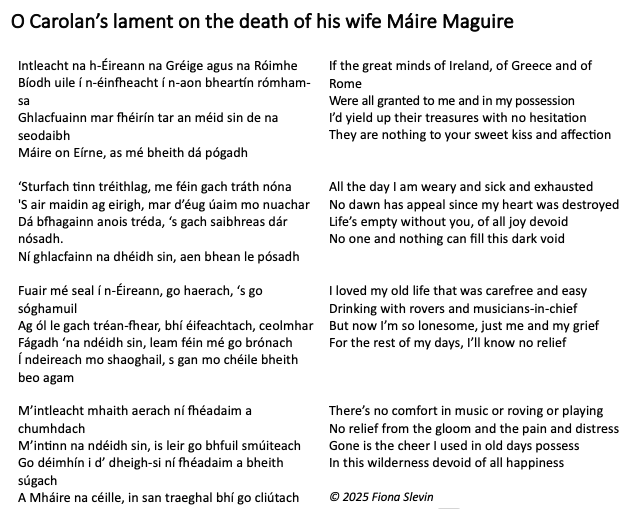
O Carolan died at Kilronan in 1738, five years after Máire. His wake lasted four days, and was marked by lavish hospitality, copious kegs of whiskey, and the music of the harp.
The sculpture of Turlough O Carolan in Mohill is highly noteworthy in itself. It is the last sculpture by the eminent Oisín Kelly (1915-1981) whose other works include the statue of Jim Larkin in Dublin. Kelly was working on O Carolan when he died, and the unfinished plaster model was prepared for casting by his assistant, Lorna Skrine. The finished bronze was unveiled in Mohill by President Hillery on 10 August 1986 and followed nearly ten years of work by a skillful memorial committee
_____________
The statue of Turlough O'Carolan in Mohill is by sculptor Oisín Kelly (1915-1981) whose other works include the statue of Jim Larkin in O'Connell St. in Dublin. Kelly was working on the statue of O'Carolan when he died, and the unfinished plaster model was prepared for casting by Lorna Skrine, who had been his assistant before his death. The finished bronze was unveiled in Mohill by President Hillery on 10th August 1986.
_____
Read more at LibraryIreland, and also a piece by Rev Canon Masterson here.
A fictional biography 'Turlough' by Brian Keenan is an excellent read.

Charles Reynolds (Cathal Mac Raghnaill) (c1496 – July 1535)
Secured the excommunication of Henry VIII
(Also Carolo Rayaldo Makraynald, and Magrannel)
_____________
Charles Reynolds was born in 1496 or 1497 in Mohill. His father was Maurus Mac Raghnaill, canon in the Church of Ardagh. By 15, he was a novice at the Augustinian Priory of St Mary in Mohill and became fluent in English, Irish and Latin. He later was educated at the University of Oxford. Reynolds opposed Henry VIII of England's separation from the Catholic Church, declining to acknowledge him as Supreme Head of the Church of England and refusing to acknowledge the annulment of his marriage to Catherine of Aragon.
During the Kildare Rebellion of 1534–5 against King Henry, Reynolds was dispatched as envoy to Rome to seek support from the Pope. In May 1535 he secured a papal promise to excommunicate King Henry of England.
Reynolds died of an ‘incurable fever’ and was buried in Archbasilica of St. John Lateran on 15 July 1535. Reynolds was convicted (attainted) of high treason in 1536.
Read more at https://en.wikipedia.org/wiki/Charles_Reynolds_(cleric) and https://www.wikiwand.com/en/Charles_Reynolds_(cleric)
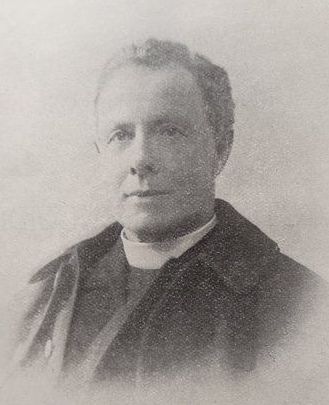
Rev Joseph G. Digges (1858-1933)
Father of Irish Beekeeping
_____________
Rev Joseph G. Digges lived at Clooncahir, Mohill. He is regarded as the father of Irish Beekeeping.
Modern Irish beekeeping owes much to a local man, the Reverend Joseph Robert Garven Digges, who although born in Dublin, he spent much of his life in Mohill, Co. Leitrim. Educated at the High School of Erasmus Smith in Harcourt St., Dublin, he later entered Trinity College as a pensioner in 1879, being awarded the degree of B.A.(Resp.) in 1882 and in 1885 an M.A. Ordained in 1883, he became deacon in Kilmore, Co. Cavan, and then curate in Mohill until 1884 and then 1884-5 at St. George's, High St., Belfast. In 1885, he became the private chaplain to the Clements family (the earls of Leitrim) at their Lough Rynn estate at Mohill. He served Farnaght and Mohill churches and from 1933 the parish of Cloone.
The Reverend Digges had his first bee-keeping lesson in 1885, at Clooncahir, and thereafter was hooked. He joined the Irish Beekeepers Association and was chairman from 1910 to 1921. He was editor of the Irish Bee Journal, (from 1912 called The Beekeeper's Gazette) published from May 1901 to October 1933. In the 33 years of publication, he only missed 4 issues - the May 1916 issue was blown up on the way to the printers during the Easter rising of that year.
Becoming proficient in bee-keeping, and anxious to promote the method of removing the honey crop from the hive without killing the bees, by using moveable frames, he started travelling extensively throughout Ireland on behalf of the Department of Agriculture and Technical Instruction, attending agricultural shows and lecturing. He promoted the "Congested Districts Hive", designed to be made and used in the poorer areas of Ireland to provide an income where the land was poor.
A great believer in promoting local industry, he helped to found the local co-operative creamery and the bank in Mohill, and was a director of the Cavan & Leitrim railway and also of the Arigna mines. Digges "was to earn high repute as a first class trouble shooter" (Flanagan, "The Cavan & Leitrim Railway" 1966) and was always sent in when problems arose.
He also published a book: The Irish Bee Guide, later renamed The Practical Bee Guide. A Manual of Modern Beekeeping, a book which came to be regarded as the standard book of bee keeping in Ireland. The book went through many revisions and reprints following its initial publication in 1904. It was self published in 1904 (by Lough Rynn Press), by the 4th edition in 1918, the publishers were Simpkin Marshall Hamilton Kent & Co. Ltd. London - later it was published by Talbot press, Dublin until its 16th edition in 1950. It sold 76,000 copies. The book was republished in 2004 to celebrate its centenary of publication.
He died dramatically during a confirmation service in Farnaght in 1933 and is buried in Mount Jerome cemetery in Dublin, beside his wife who had died in 1926. He had married Edith Bate in Belfast in 1885 and they had a son and daughter, spending their life in great comfort in the beautiful rectory at Clooncahir. A splendid stained-glass memorial window by Ethel Rhind (1877-1952) was placed in the church, which shows St. McDomnoc (Molagga) bringing the bees to Ireland.
_____
This text is based on an article by Petra Coffey and email of Jim Ryan).
For an overview of how important honeybees were in early Irish society and how they were regulated under the Brehon Laws, see
https://thebrehonlawyer.com/2021/03/31/bees-and-neighbourhood/
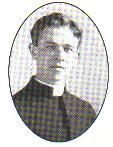
Fr Tom Ellis (1906-1945)
Missionary priest 'St. Thomas of Mohill'
_____________
Fr. Tom Ellis was a Mohill-born, missionary priest, who died in 1945 in China. He is revered in China and the cause for his canonisation was actively pursued.
One of a family of five, Tom was the son of leather merchant Richard Ellis, Main St. Mohill, Co. Leitrim and his wife Ellen Jane Mahon. He was born on January 12, 1906.
As a small boy, he was educated firstly as an infant in St. Josephs and then on to the Boy's school, Mohill and finally as a boarder in St. Mel's, Longford. He studied for the priesthood in Maynooth and was ordained in April 1931. Shortly afterwards, he set off from Cobh, Co. Cork for the missions in Nancheng (now Hanzhong) China, then only five years in existence.
On his first day in his new land, Fr. Tom met a man suffering from dysentery lying on the street, brought him back to the church and washed him clean, thus beginning his labours for those in want, a work that would continue until his death 14 years later. Such were the qualities of Fr. Tom Ellis that soon he was attracting large numbers of local people, in search of material and spiritual help. Three years after going to Nancheng, on Christmas Eve 1934, with Fr. Dennehy, a total of 133 Baptisms were performed. Fr. Tom's practical side saw him helping the local people through starting handicraft industries and technology projects.
In June 1942, the Japanese army arrived in Nancheng, and life became more difficult for the population as a whole. Many stories are related of Fr. Tom's work in saving lives: on one occasion he stepped in front of Bishop Patrick Cleary while they were being shot at by the Japanese. He never spared himself and while giving a mission at Wangtien-Tang, he became ill, succumbing to typhoid fever on March 5th (or 8th) 1945.
The story is told that before he died, a Columban sister commented: "You work so hard, what saint will you be when you die?" to which he joked: "I'll be Saint Thomas of Mohill".
Soon after his death, it is said, he gave a sign to his fellow priests of impending trouble - just a month later, Bishop Cleary and all of the other priests were publicly tried and forced to flee China. The emergence of a communist government meant the suppression of Christianity. Despite this, believers flocked to Fr. Tom's grave in throngs, resulting in the desecration of the grave. His remains were removed to Shanghai for safety.
Bishop Cleary (1886-1970) later wrote a book on Fr. Tom and sent it to Rome, asking that Fr. Tom Ellis be canonised. A second book on his life, "Passing the Torch" has been written by Fr. Luke O'Reilly. It is claimed that two Chinese women, seriously ill have been cured after praying to him, and a Lutheran doctor, Dr. Otta Homberger, and Dr. Yeh have confirmed the reality of the cures. It is believed that a committee in Mohill is praying for his canonisation.
______
This is based on an un-credited article which appeared in 'The Irish Family', February 7, 2003.
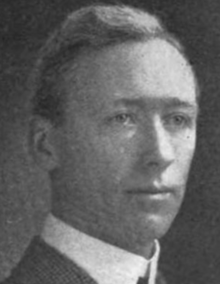
John Hart
Premier, British Columbia
_____________
John Hart was born in Mohill in 1879, the son of a farmer. He emigrated to Canada in 1898. He first worked in the finance industry and founded his own firm in 1909. About the same time he married Harriet McKay. He entered politics as a liberal in 1916 and for a number of years served as minister for Finance. He became premier following the 1941 election and formed a coalition government with the conservatives.
After 1945, Hart undertook an ambitious programme of rural electrification, hydroelectric and highway construction. His most significant projects were the construction of Highway 97 to Northern British Columbia and the relaunch of the Bridge River Power Project, which was the first major hydroelectric development in British Columbia. In December 1947 he retired from politics to concentrate on business. He was one of the few British Columbia premiers who left office neither defeated nor under a cloud. The 405 kilometre John Hart Highway between Prince George and Dawson Creek is named after him as is the Hart Highlands neighbourhood of Prince George, and the John Hart dam (hydroelectric) in Campbell River.
Hart died in 1957, aged 78 years, having led a distinguished life in public service. He is buried in the Royal Oak Burial Park in Saanich, British Columbia.
_____
From Leitrim Treasure: Generations of historical, social and human Interest stories, (Sliabh an Iarainn Committee, 2013).
Read more at https://britishcolumbiahistory.ca/sections/politics/Premiers/John_Hart.html
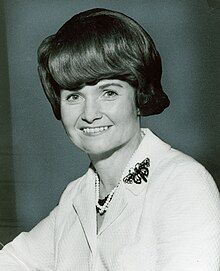
Margaret M. Heckler
US ambassador to Ireland
_____________
Born Margaret Mary O'Shaughnessy in 1931, the daughter of John and Bridget O'Shaughnessy (neé McKeon). Heckler called Although born in New York, as a nine-year old, Heckler moved with her parents to her mother's home place in Gortnalamph, near Mohill, where they stayed for one year.
Heckler was the sole woman in her class at Boston College Law School, and ranked amongst the top graduates. She joined the Republican party, and represented Massachusetts in Congress for 16 years, becoming the first woman to be elected who did not succeed her husband. She supported the Equal Rights Amendment and was the lead House sponsor of the 1974 Equal Credit Opportunity Act, which barred banks and other lenders from discriminating against women based on their gender or marital status. Heckler was also a founder of the Congressional Women’s Caucus in 1977. It later admitted men and became the Congressional Caucus on Women’s Issues.
Her tenure at the Department of Health and Human Services (HHS) was brief. She served about 31 months before being forced out. She was appointed ambassador to Ireland in 1885. She was instrumental in driving the US government to donate $120 million to the International Fund for Ireland.
______
From multiple sources including 'Irish America', September/October 2018, and The Irish Times, 11 August 2018.
Remembering and celebrating great Mohill women
Many Mohill Women – ordinary women – never became famous, but they built families, businesses and created the town and countryside of Mohill that we know today.
In August 2024, I set out to tell some of these women's stories.
Download a summary by clicking on the
map opposite >>>
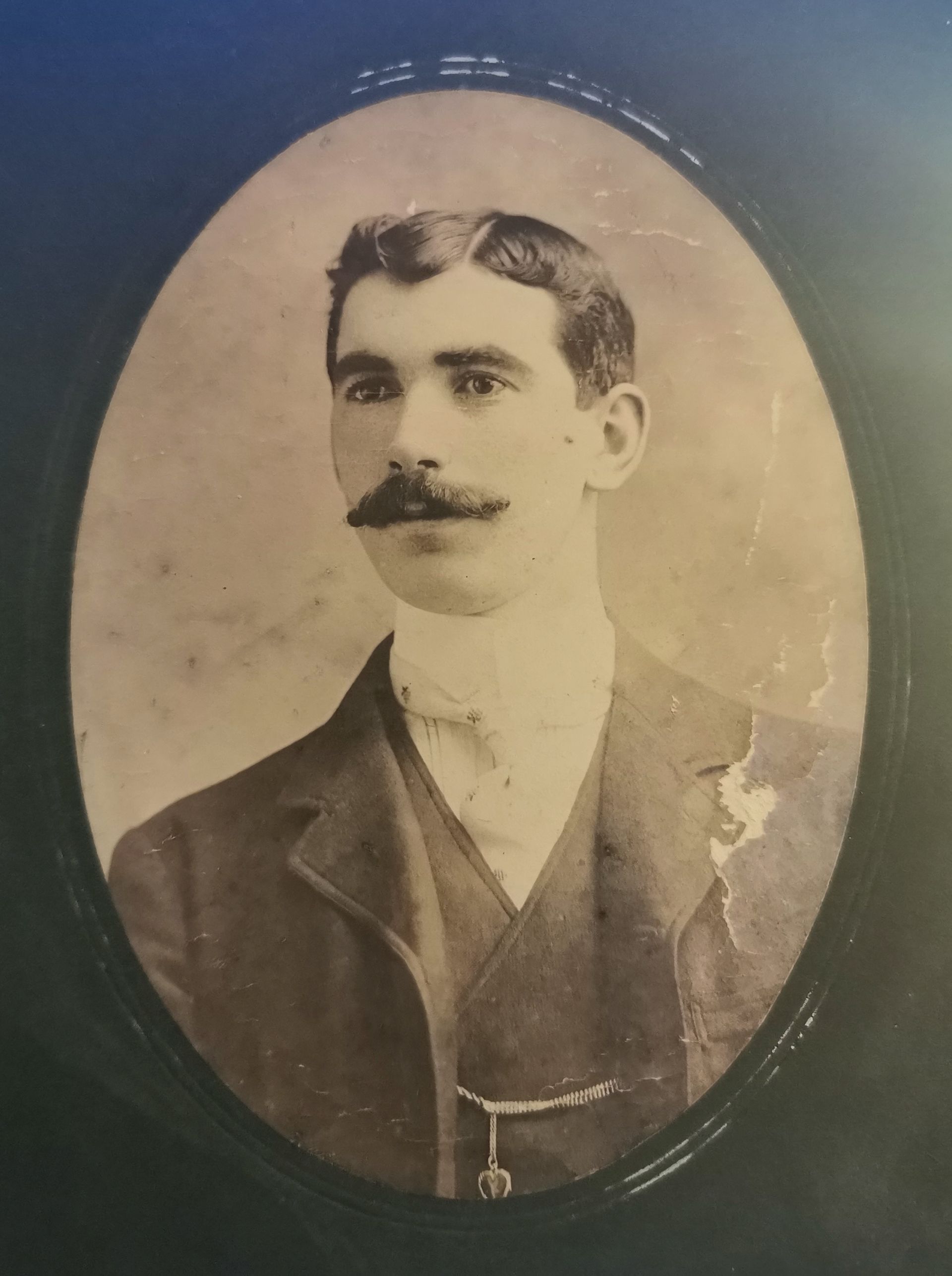
Malachy McGarry
Inventor of Buck's Fizz
_____________
Malachy McGarry, the Mohill man who invented Buck's Fizz and probably the Sidecar.
McGarry invented Buck's Fizz in London in 1921 when he was a barman at the Buck's Club, a gentlemens' club in Mayfair, London.
McGarry was born near Cloonboniagh outside Mohill.
McGarry (also known as Pat) was hired as a cocktail maker by Captain Herbert John Buckmaster who opened the Buck's Club in 1919 after WWI. McGarry had served in the Irish Guards. The club was a less formal American style than other clubs.
Dr Dolan writes that David Niven was an apprentice, and Ernest Hemingway and PG Wodehouse were regulars: Buck's club inspired Wodehouse's fictional Drones club, and he names the bartender 'McGarry'.
Captain Peter Murison, the Buck's Club secretary, wrote that while Buckmaster was going through a divorce from his wife, actress Gladys Cooper, McGarry would be alongside Buckmaster, hosting parties with movie and theatre starts and club members. One evening, a club member, asked for a cocktail that was doing the rounds in Europe made of peach juice and champagne.
McGarry came up with his own version, replacing the peach with orange juice. While that remains the basic Buck's Fizz recipe, McGarry had his own secret version which involved adding a dash of gin and cherry brandy.
The Buck's Club inspired the fictional Drones club that features heavily in the books of P.G. Wodehouse, where Bertie Wooster often goes to hatch plans, drown sorrows, and generally get a little 'tight'.
Malachy died in 1941. His family in Mohill still have his corkscrew.
References:
At the foot of the Sheemore hills,
by Dr Arthur Dolan;
read his full piece here >>>
Signature Cocktails by Amanda Schuster
With thanks to Edel McGarry, grand-niece of Malachy.

Buck's McGarry*
- 60 ml fresh orange juice
- 90 ml Champagne or other dry bubbly
- Splash of good dry gin
- Dash of cherry brandy
- Garnish: orange twist
Build the drink in a flute or wine glass.
Stir. Add the orange twist to garnish.
* I'm renaming this! Originally Buck's Fizz and Champagne Buck.

McGarry's Sidecar*
- 50 ml brandy/cognac/armagnac (to taste)
- 25 ml triple sec
- 25ml lemon juice
- Garnish: orange twist and/or sugar rim
This is one that you can make to taste in a 3-2-1 or 2-1-1 ratio as above.
Add all ingredients with ice to a cocktail shaker. Shake well. Pour and enjoy.
* I have no idea how Malachy McGarry made his sidecar, but am naming this in his honour.
Other famous Mohill people
In 2018, I asked OldMohill members on Facebook to suggest famous Mohill people: here is the list in alphabetical order.
- Alan Early, author
- Beirne Family, Ireland’s Fittest Family, 2017
- Chris Meehan, Barrister and long-time leader of Chris Meehan and his Redneck Friends
- Douglas Hyde (first president of Ireland), whose grandfather lived at The Glebe
- Eanna Madden, athlete
- Fred Dobson, dog breeder and competition winner
- Gerry O’Reilly, owner of Bad Bob’s club and The Gaiety Theater in Dublin in the 1980s
- James McCombs, New Zealand parliamentarian and liberal
- Jennifer Wrynne, milliner and style leader
- John Drummond, musician (and associated with theme tune from Wanderly Wagon)
- John Hart, 23rd Premier of British Columbia, Canada 1941-1947
- John Manning and Leo Boland, veteran heroes of Siege of Jadotville
- John McGahern, writer
- John Murray (of Tulcon), grandfather of James Joyce
- Katherine Lynch, actress, comedian, singer
- Lloyd Donnelly, master of Old Mohill Facebook Group!, keeping the community flame alive
- Matthew Sadlier, died on the Titanic
- Mohill Show Committee, keepers of the Mohill Show flame for decades
- Packy McGarty, great Leitrim footballer who played for Leitrim for four decades from 1949-1973
- Pádraic Óg Gallagher, Gallagher’s Boxty House, Temple Bar, Dublin and potato expert
- Pat Quinn, founder of Quinnsworth and inventor of term ‘yellow-pack’
- Patrick McGoohan, actor
- Philomena Barry, author
- Promenade, local band from 1988
- Rev. J.G. Digges, ‘Father of Irish bee-keeping’
- Teresa Bohan, first female GAA county board president GAA (Leitrim GAA 2001)
- Thomas Casey, sportsman (Guinness Book of Records?)
- Turlough O’Carolan, last Irish bard
- William Sydney Clements, Lord Leitrim
